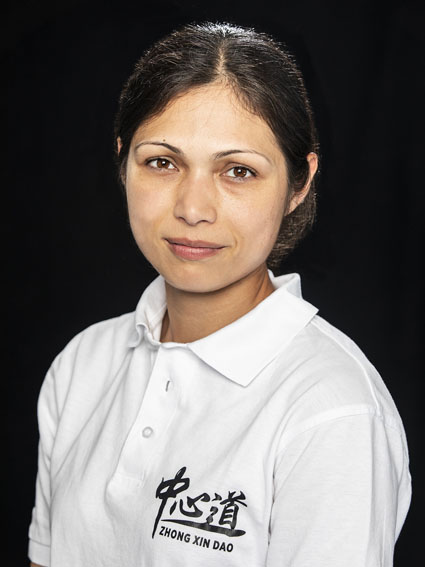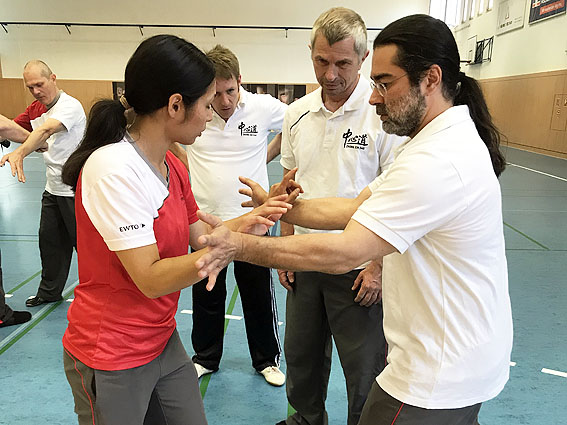The most important things are already in the first lessons!
For over 16 years I have experienced and lived with WingTsun on a daily basis, as what might be called an ″in-house student″ of Sifu Kernspecht. For him, literally everything revolves around WingTsun, and all other topics are merely reference points to be applied to WT.
 As a member of the family, I have experienced all phases of study at first hand, have always been actively involved and feel a particular affinity for ReakTsun, which I was allowed to help design. ReakTsun is so soft and effortless that it is ideal for women and more slightly built men. ReakTsun meant everything to me..
As a member of the family, I have experienced all phases of study at first hand, have always been actively involved and feel a particular affinity for ReakTsun, which I was allowed to help design. ReakTsun is so soft and effortless that it is ideal for women and more slightly built men. ReakTsun meant everything to me..
However, SiFu‘s motto is: "Better is the enemy of good!", and as soon as he has invented or found something, he immediately begins to find or develop the antidote:
In 1959, when he had hardly mastered Jujitsu/Judo, he became fascinated with robot-like Karate. First Kyokushin (Oyama style) and then Shotokan. Then he invented ways to neutralise them for himself. Having exhausted his own possibilities, he found the "antidote" wing chun in the form of his first SiFu, Joseph Cheng in London, who referred him to Sifu Leung Ting (WingTsun) in Hong Kong in 1976 – in the 1970s he even began to call it "Anti-Karate", an unfortunate expression which he later regretted, as he is anything but an opponent of Karate. Indeed he has much to thank Karate for, especially the fighting spirit of the Samurai, which he imparts to his WingTsun students to this day, though this no longer seems to match the spirit of the age nowadays.
He retained his uncritical satisfaction with wing chun/WingTsun for 9 years, until he came across the book "Between Wing Chun and Jeet Kuen Do" by Jesse Glover. A few weeks later SiFu – at that time a 3rd TG/HG in WT – and Simo were already in Seattle (USA) studying the precursor to Bruce Lee’s non-classical wing chun variant "Jeet Kuen Do" with Bruce Lee’s first student, first assistant and best fighter Jesse Glover.
In 1984 SiFu confronted his own Chinese SiFu Leung Ting with Jesse Glover’s lightning-fast "attacking wing chun". He wanted to find out what defences WingTsun has against it (at least theoretically). The result clearly convinced SiFu, as he continued his private WingTsun studies with his Chinese SiFu until 2008, i.e. even after having been awarded the 10th Master Level in 2000.
Since then SiFu has been interested in "inner" styles, which he previously rejected as "nonsense" because representatives of such styles were unable to convince him in practice.
Here too, he began to experiment for himself because he did not want to be distracted by the already well-established TaiChi or have his creative imagination restricted. At some point he came across a northern Chinese (!) master who even showed him an inner version of wing chun..
SiFu refused to believe that the Hong Kong wing chun or WingTsun he had been shown was everything there was to learn, as he is a strong believer in lifelong learning.
During his own experiments he discovered phenomena that gave him surprising advantages in combat, though at the time he was unable to put them into words.
It was his mentor and later friend Prof. Horst Tiwald in Hamburg who helped him to do this by sketching out a credit and debit account of what his WingTsun already had and what it lacked to be a complete, inner style, and by suggesting where he might obtain it.
This gave rise to SiFu‘s conviction that everything about a system can be improved if it is transformed into an inner system. Such a transformation even includes the "Big Seven", the capabilities it is essential to develop for SiFu‘s WingTsun, and even exceeds them.
In 2012, after Tai Ki Ken which SiFu had already encountered during his Kyokushin Karate time, and on the advice of Prof. Tiwald, he began to concern himself with Yi Chuan, a derivative of Hsing-I though without its forms, which we both studied under SiFu’s friend and colleague, the inner master Yang Lin Sheng from Mongolia.
We also received introductions to Yang and Chen Tai Chi, Hsing-I, Pakua, Southern Praying Mantis and White Eyebrow etc. from masters in these styles.
In 2014, in the form of GM Sam Chin, SiFu eventually discovered I Liq Chuan/Zhong Xin Dao, a style then practically unknown in Europe, in which SiFu and I will have absolved around private lessons by the end of 2019.
This inner style gained SiFu‘s interest because it perfectly suits his own linkage theory so highly praised by Tiwald, and because SiFu considers it to be the best preparation for inner combat and for an understanding of all inner styles.
Many disconcerted EWTO members now ask us whether it is necessary to learn ZXD to understand WT. Naturally this is not the case, as WingTsun is completely self-explanatory!
SiFu‘s own motivation is based on his wish to develop his WingTsun into an inner system, i.e. into the highest WingTsun, and for this he needs a programme of exercises and tasks.
In its first two programmes ZXD/ILC already provides the fundamental basis for all inner styles. It has specific exercises that help to develop and apply most of the essential seven capabilities, and especially the first one, namely mindfulness.
Just as SiFu recommends that each of his students learns the basic strikes and defences in the first two Escrima programmes, and also the principles of grappling/groundfighting, he considers that every WT member should get to know the inner fundamentals (mindfulness, structure, stance, energy, etc.).
By now almost 100 WT teachers have undergone the introduction to inner KungFu, therefore the knowledge is available within the EWTO.
 The circling arms (ZXD programme 5), on which we place a particular focus, are perhaps the greatest treasure of ZXD. In the old wing chun of Dr. Leung Jan there were also circling arms, and they have survived in Vietnamese wing chun, though in Hong Kong and most regions of mainland China, there are unfortunately only the conventional rolling arms (PoonSao).
The circling arms (ZXD programme 5), on which we place a particular focus, are perhaps the greatest treasure of ZXD. In the old wing chun of Dr. Leung Jan there were also circling arms, and they have survived in Vietnamese wing chun, though in Hong Kong and most regions of mainland China, there are unfortunately only the conventional rolling arms (PoonSao).
SiFu takes the view that our WingTsun was originally an inner style, and wants to give back to it as many of the inner qualities that he believes (or would like to believe) it still had in around 1850.
However, those who only want to learn WingTsun to learn WingTsun do not need to give much thought to such things.
They do not need to acquire a basic knowledge of Escrima, grappling or ChiKung, nor of ZXD/ILC.
For (future) masters they can serve as auxiliary sciences without having to learn them completely – the first one or two programmes are sufficient!
At some time SiFu once wrote that the most important things are already said during an introductory lecture in a university – if the professor takes his/her task seriously.
As a representative of ZXD/ILC in the EWTO, I am naturally pleased whenever anybody chooses to study the material further after the first programme …
Your Natalie
ZXD-Instructor
5th HG WingTsun
Photos: aw/hm


